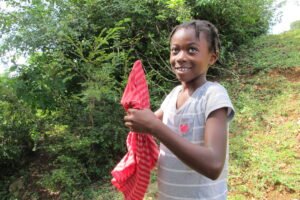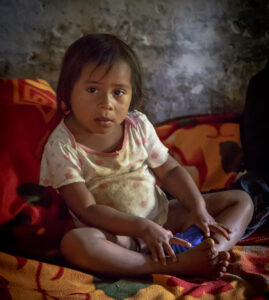Written by Nathalie Pratt, PWW team
 When my son was young, my return home from travels to Haiti and Honduras would be met with many questions. He was curious about life in these places I would visit, especially life for children like him.
When my son was young, my return home from travels to Haiti and Honduras would be met with many questions. He was curious about life in these places I would visit, especially life for children like him.
One morning we sat over breakfast talking about the morning routine of a child in Honduras. We discussed the differences, everything from children sleeping in their 1-2 room home, usually without a cozy bed and alongside their many siblings and parents, and maybe even alongside their grandmother and other relatives. We talked about children having to get up early to go collect water for the family before school, sometimes traveling long distances from home.
But what really left him stumped that morning came after I asked him to share his morning routine. It started with me asking, “what happens after you wake in the morning?”
“I get up and eat breakfast,” my son answered.
I slowed him down, asking, “But what do you do right after you wake up?”
Confused, he inquisitively replied, “Open my eyes?”
I pressed on. “After you open your eyes and get out of bed, where do you go?”
Again, wondering about this potential trick question, he replied, “To the bathroom?”
“Yes!” I affirmed, following with the question, “but what if you had no bathroom?”
He sat quietly, contemplating what that meant, then wittingly responded, “I would use your bathroom!”
Again, I pressed on, “But what if the whole house had no bathroom?”
He looked at me with his big, trusting eyes, searching for the answer and simply replied, “I don’t know.”
The story continues from there, with many additional stories shared in the years that followed. But this one really stuck out, as it was so very difficult for this young person to understand. Having already traveled quite a bit himself, he knew about safe and unsafe water, so he could somewhat understand that issue.
But how was it possible that families live without a bathroom? Without a toilet? This was too much for him to get his head around.
Yet, this profound truth remains today…
- Almost 50% percent of the people on our planet, 3.6 billion, live either without a toilet altogether or without one that safely manages waste. (source)
- At least 2 billion people use a drinking water source contaminated with feces. (source)
- 494 million people on our planet have no sanitation facilities at all and no choice but to practice open defecation. (source)
- What is “open defecation”? It is described as the “practice of defecating in fields, forests, bushes, bodies of water, or other open spaces. Defecating in the open is an affront to dignity and risk to children’s nutrition and to community health.” (source)
Open defecation has numerous negative health and social impacts, including being the cause and/or direct contributor to the spread of infectious diseases, diarrhea, malnutrition, and adverse pregnancy health outcomes. It also causes increased vulnerability to violence, particularly for women and girls.
 What do I mean particularly for women and girls? The lack of a safe toilet at home is especially harmful to females, creating significant vulnerabilities and impacting their overall health, safety, and wellbeing. Without facilities at home, women and girls are forced to walk from their homes in search of a private place to defecate and manage their monthly menstrual cycles. This may leave them vulnerable to verbal, physical, and sexual violence. Women and girls often wait long periods before relieving themselves, making them more susceptible to urinary infections and other harmful diseases.
What do I mean particularly for women and girls? The lack of a safe toilet at home is especially harmful to females, creating significant vulnerabilities and impacting their overall health, safety, and wellbeing. Without facilities at home, women and girls are forced to walk from their homes in search of a private place to defecate and manage their monthly menstrual cycles. This may leave them vulnerable to verbal, physical, and sexual violence. Women and girls often wait long periods before relieving themselves, making them more susceptible to urinary infections and other harmful diseases.- On top of that, lack of safe toilets at schools negatively impacts a girl’s ability to attend and complete school. With no access to safe and private WASH facilities, menstruating girls regularly miss school, most eventually leave altogether, limiting them from reaching their full potential.
 Unsafe sanitation has been named as one of the world’s largest health and environmental problems. (source)
Unsafe sanitation has been named as one of the world’s largest health and environmental problems. (source)
- Responsible for approximately 775,000 deaths every year, unsafe sanitation is a leading cause of diarrheal disease, which contributes to the death of ~525,000 children under the age of five, annually. (Photo credit: Tony Gilmore)
- Inadequate and nonexistent sanitation facilities leads to the contamination of the environment, including the water and the soil, providing a host for harmful pathogens and parasitic worms that infect hundreds of millions of people across the globe.
Sadly, the list goes on.
We share statistics like these because they are shocking. They are shocking because they are true. At PWW, we are committed to doing everything we can to change them.
But, please remember, these are not just statistics. They are data representations of human beings, moms and dads, sons and daughters, brothers and sisters, grandmas and grandpas who were born into their life circumstance and simply want a chance at a healthy, happy life. Just like us.
World Toilet Day is Saturday, November 19th.
 Will you join me and help change these statistics?
Will you join me and help change these statistics?
Just $200 funds the materials and training for a family to build a safe and proper toilet in Honduras. This basic home necessity provides the entire family with an opportunity for vastly improved health and wellbeing, while protecting their home and environment. A simple toilet, something I know I take for granted in my home, offers safety and dignity that can change the course of a family’s future.
Today my son is 18. He still possesses great curiosity about the world; however, he also carries a profound determination to make the world a better place for all living beings.
Let’s do this. Let’s make stories like what I shared with my son a part of history. Starting today. Will you join me? Donate to share the gift of a toilet.

